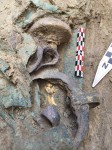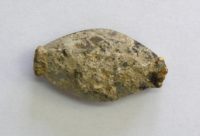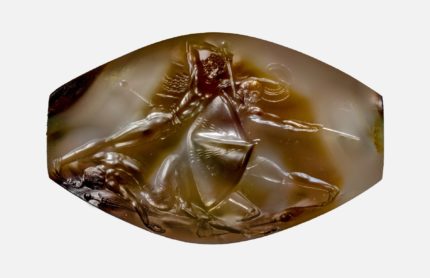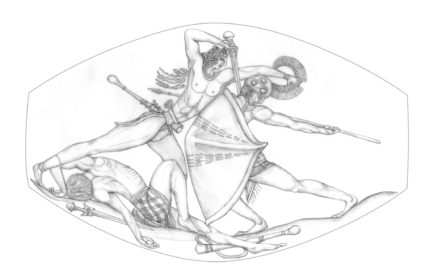 When the intact grave of a Bronze Age man was discovered in Pylos, southwestern Greece, two years ago, it was so dense with luxurious grave goods that it set a new record for the wealthiest single grave ever found in Greece. Its location, next to the so-called Palace of Nestor of Trojan War fame, and the richness of the contents even generated breathless speculation that this might be the tomb of a Homeric hero. Entirely groundless speculation — the shaft tomb is around 300 years older than the palace which was destroyed in 1,180 B.C. — but it’s an inescapable side-effect when archaeologists discover ivory-handled, gold-covered weapons, four gold signet rings, more than 1,000 semi-precious stone beads, silver and bronze cups, a massive gold chain, 50 seal stones decorated with Minoan motifs, carved ivory and ever so much more, enough to reignite a million childhood fantasies of pirate booty treasure maps where X always marks the spot.
When the intact grave of a Bronze Age man was discovered in Pylos, southwestern Greece, two years ago, it was so dense with luxurious grave goods that it set a new record for the wealthiest single grave ever found in Greece. Its location, next to the so-called Palace of Nestor of Trojan War fame, and the richness of the contents even generated breathless speculation that this might be the tomb of a Homeric hero. Entirely groundless speculation — the shaft tomb is around 300 years older than the palace which was destroyed in 1,180 B.C. — but it’s an inescapable side-effect when archaeologists discover ivory-handled, gold-covered weapons, four gold signet rings, more than 1,000 semi-precious stone beads, silver and bronze cups, a massive gold chain, 50 seal stones decorated with Minoan motifs, carved ivory and ever so much more, enough to reignite a million childhood fantasies of pirate booty treasure maps where X always marks the spot.
 After the dust from the dig had settled, the team, led by University of Cincinnati archaeologists Jack Davis and Sharon Stocker, had unearthed more than 3,000 burial objects, all of which were sent to the Archaeological Museum of Chora for triage, study and conservation. One of the objects was a small sort of kite-shaped piece caked in thick lime accretions entirely obscuring its surface. It was put in the To Do pile while conservators focused on the larger ticket items, like the heaps of gold, weapons and jewels.
After the dust from the dig had settled, the team, led by University of Cincinnati archaeologists Jack Davis and Sharon Stocker, had unearthed more than 3,000 burial objects, all of which were sent to the Archaeological Museum of Chora for triage, study and conservation. One of the objects was a small sort of kite-shaped piece caked in thick lime accretions entirely obscuring its surface. It was put in the To Do pile while conservators focused on the larger ticket items, like the heaps of gold, weapons and jewels.
They were finally able to beging cleaning the wee thing — it’s less than an inch and a half long — a year later and discovered that under all lime scale was one of the greatest pieces of art in Greek history. It’s a sealstone, not made of precious metals like the signet rings found in the tomb, but of agate. This one’s value is in the astonishing detail and precision in the miniature carving.
The “Pylos Combat Agate,” as the seal has come to be known for the fierce hand-to-hand battle it portrays, promises not only to rewrite the history of ancient Greek art, but to help shed light on myth and legend in an era of Western civilization still steeped in mystery. […]
Davis and Stocker say the Pylos Combat Agate’s craftsmanship and exquisite detail make it the finest discovered work of glyptic art produced in the Aegean Bronze Age.
“What is fascinating is that the representation of the human body is at a level of detail and musculature that one doesn’t find again until the classical period of Greek art 1,000 years later,” explained Davis. “It’s a spectacular find.”
Even more extraordinary, the husband-and-wife team point out, is that the meticulously carved combat scene was painstakingly etched on a piece of hard stone measuring just 3.6 centimeters, or just over 1.4 inches, in length. Indeed, many of the seal’s details, such as the intricate weaponry ornamentation and jewelry decoration, become clear only when viewed with a powerful camera lens and photomicroscopy.
“Some of the details on this are only a half-millimeter big,” said Davis. “They’re incomprehensibly small.”
The miniature masterpiece portrays a victorious warrior who, having already vanquished one unfortunate opponent sprawled at his feet, now turns his attention to another much more formidable foe, plunging his sword into the shielded man’s exposed neck in what is sure to be a final and fatal blow.
This thing is unbelievable. I think I’ve stared at the fallen fighter on the left for a solid hour.

Here is an enlarged drawing of the artwork so you can see the astonishing detail the carver was able to achieve with whatever meagre magnification options were available in 1,500 B.C. (or maybe none at all):

Beyond all the superlatives that can and should be showered upon this marvel of artistry, researchers believe the sealstone reveals new information of major significance about Minoan culture and their interactions with the Mycenaeans who so thirstily drank of Minoan culture and spread it throughout the Greek mainland.
In a series of presentations and a paper published last year, Davis and Stocker revealed that the discovery of four gold signet rings bearing highly detailed Minoan iconography, along with other Minoan-made riches found within the tomb, indicates a far greater and complex cultural interchange took place between the Mycenaeans and Minoans.
But the skill and sophistication of the Pylos Combat Agate is unparalleled by anything uncovered before from the Minoan-Mycenaean world, say the researchers. And that raises a bigger question: How does this change our understanding of Greek art in the Bronze Age?
“It seems that the Minoans were producing art of the sort that no one ever imagined they were capable of producing,” explained Davis. “It shows that their ability and interest in representational art, particularly movement and human anatomy, is beyond what it was imagined to be. Combined with the stylized features, that itself is just extraordinary.”
The revelation, he and Stocker say, prompts a reconsideration of the evolution and development of Greek art.
“This seal should be included in all forthcoming art history texts, and will change the way that prehistoric art is viewed,” said Stocker.
For more about the Griffin Warrior tomb, check out this thoroughly documented, content-rich website created by Davis and Stocker and the Pylos team. Pictures are a bit small, alas, but they need to pinch bandwidth pennies because conserving an enormous quantity of priceless archaeological artifacts is an expensive proposition, especially trying to keep the fragmentary bronze armour from falling apart. You can contribute to the project here. All donations go directly to conservation.